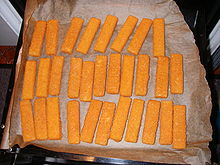Parchment paper

Baking paper is a coated paper . It is placed in baking tins and on baking trays to prevent the baked goods from sticking. This eliminates the need for greasing , which was previously often used . Normally it should only be used up to a temperature of 250 ° C and should not come into contact with heat sources such as grill sticks.
In the past, parchment paper coated with different types of fat was mostly used. Today, baking papers can be roughly divided into several classes:
- the slightly more expensive, but also longer and at higher temperatures usable silicone-coated baking papers (also silicone baking mats or permanent baking foil) and
- the cheaper Quilon-coated baking papers, in which a complex of chromium (III) salts and fatty acids ensures the sealing of the paper surface, but due to this baking paper sealing, a maximum of half an hour at max. 200 ° C should be used.
- Baking papers with a coating of fluorocarbon compounds ( perfluorooctanoic acid ) should no longer be used due to the bioaccumulation of the coating materials.
In Europe today it is mainly the silicone-coated variants on offer.
Metsä Tissue is the world's largest manufacturer of baking paper with its SAGA product. 99% of the baking papers sold in Germany are manufactured in the Birkesdorf plant.
history
It is already known from the Roman recipe collection De re coquinaria des Apicius that paper was used to cover or wrap dishes that were to be prepared in the oven.
German writings from the 17th to 19th centuries show how paper was made that could withstand a moderate fire. In the kitchen, papers were greased with butter or tree oil to prevent the food from burning into the roasting vessels in the oven.
similar products
- Grease and oil papers - are less heat-resistant and are used for packaging fatty foods
- Waxed paper - coated paper for packaging moisture-sensitive objects
- Greaseproof paper
Individual evidence
- ↑ Quilon Products Datasheet (PDF; 591 kB), last accessed June 24, 2013.
- ↑ http://www.sagacook.com
- ↑ Apicius: The Roman cookery book . Harrap, 1958, p. 193, 195 ( google.de [accessed on May 2, 2018]).
- ↑ Johannes-Sigismund Elsholtz: Doktorney-Garten and Tisch-Buch or continuation of the Gartenbaw, how to use the earth plants, herbs, flowers and roots shown by God to maintain good health, well use and apply, also maintain and maintain one's life could . 1690, p. 463 ( google.de [accessed on May 1, 2018]).
- ↑ Curieuse Kunst- und Werck-Schul: Teaching all kinds of fire arts, metallic gold u. Silver samples, pearls, rivers ... Zieger, 1696, p. 688 ( google.de [accessed on May 1, 2018]).
- ↑ General economic lexicon - In addition to an appendix of an agriculture and housekeeping calendar . Gleditsch, 1764, p. 991, 1035 ( google.de [accessed on May 1, 2018]).
- ^ Friedr Luise Löffler: New cookbook; or Approved instructions for the tasty preparation of dishes, baked goods, confit, frozen and preserved foods . JF Steinkopf, 1825 ( google.de [accessed May 1, 2018]).
